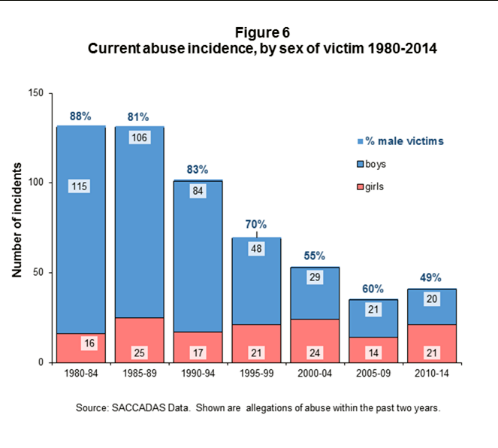Originally Published February 7, 2022
Updated February 17, 2022
This article was originally published in The National Catholic Register, by Dr. Jennifer Roback Morse.

Clergy sex abuse in the Catholic Church is not “over.” I mean this in two ways.
First, some clergy sexual abuse is undoubtedly still taking place. But more importantly, we haven’t really dealt with the situations we already have experienced. Investigating the allegations, sending the guilty to prison, Church officials making amends to the victims, including financial payments — all this is important. But we as the larger Church community need to face the larger fact: A problem like childhood sexual abuse has many layers. Each incident affects numerous people, including family members and the parish or school community. We aren’t “done,” we haven’t “solved” clergy sex abuse, until we deal with all these social, emotional, and spiritual issues, along with the legal and financial issues.
Before I unpack all that, though, let’s recap some of the statistics. A look at the data will show beyond any shadow of a doubt that, although clergy sex abuse has declined in the Catholic Church, it isn’t gone.
My colleague Father Paul Sullins systematically analyzed data on clergy sexual abuse in two separate reports, “Is Catholic Clergy Sex Abuse Related to Homosexual Priests?” published in 2018 and “Receding Waves: Child Sex Abuse and Homosexual Priests Since 2000,” published in 2019. The second report included data going all the way up through 2018, based on diocesan reports required by the Dallas Charter. As far as I know, Father Sullins is the only person to do a statistical examination of the data the Church has been dutifully collecting each year.
Number of Abuse Incidents reported in the same year they occurred by sex of victim, 1980-2014:

He found data that suggests the problem has shifted. Recent victims are more evenly divided between male and female, instead of the preponderance of male victims from earlier times. Importantly, the age of the victims has shifted toward older victims: There are fewer pre-pubescent victims and more teenage victims today. He did find some hopeful news, which suggests the problem has improved. Recent data shows fewer reported cases among younger, recently ordained priests.
So, it is accurate to say that the situation is improved, and there is reason for hope.
However, relying on the fact that few incidents have been reported recently is no reason to pat ourselves on the back and say that all is well. The problem is that most survivors do not report their abuse until much later. In fact, in his first study, which used the Pennsylvania grand jury reports, Father Sullins found that the average reporting lag was more than 28 years.
I noted this issue back in 2019, when Father Sullins’ second report came out. He found that in the period between July 2, 1017, and June 30, 2018, a total of 1,385 survivors of child sexual abuse by clergy came forward making 1,455 allegations. Of those allegations, only 26 allegations involved minors that took place during 2018.
Can we be certain that these 26 are the only incidents that took place in this period? Obviously not. The bulk of the incidents newly reported in 2017-2018 did not take place during that period but were spread out over all the earlier years.
As I said at the time:
“Father Sullins addressed that issue by comparing year-to-year allegations of current abuse. In other words, he went back to the historic data and asked this question, ‘In 1950-1954, how many people came forward to say they were abused in 1950-1954? How does that compare with the number of people coming forward between 1955-1959 to say they were abused between 1955-1959?’ And so on. Bringing those numbers up to the present does not paint such a rosy picture of rapidly declining clergy sexual abuse.”
This is precisely where Father Sullins found a disturbing increase in sexual abuse of minors since 2002. The priest sexual abuse of children dropped to an all-time low just after 2002, but it has since risen. (See Figure 6 from the report, reproduced above.) It is true that clergy sexual abuse of minors remains well below its peak in the 1980s. Reports of current abuse averaged 8.2 per year from 2010 to 2014. In the 1980s, there were an average 26.2 reports of current abuse per year.
Besides the statistical analysis, there are a few other troubling “data points” that do not directly involve crimes against minors. The discovery that Msgr. Jeffrey Burrell, the general secretary of the U.S. Conference of Catholic Bishops, had been habitually using the gay dating app Grindr was disturbing, to say the least. He had held a critical oversight role in the Catholic Church’s response to the recent spate of sexual abuse and misconduct scandals. Msgr. Burrill resigned and has dropped out of public sight.
Anthony Gorgia’s allegations of sexual harassment against seminarians at the North American College (NAC) in Rome do not involve minors, and so are not criminal acts. Gorgia claims that he witnessed the vice rector, Father Adam Park inappropriately touching a seminarian. Gorgia claimed that other seminarians reported similar incidents. After the claim was filed, a representative from the NAC expressed confidence in the rector and staff and their defense with “the facts of the matter.” Gorgia’s lawsuit against the NAC was dismissed on technical grounds, so the allegations were not examined in court. Like Msgr. Burrill, Father Park has disappeared seemingly without a trace and without explanation.
None of this inspires confidence.
Nor frankly, does the Vatican’s McCarrick Report. The authors of the report didn’t even mention James Grein, one of McCarrick’s victims. The report did not adequately answer the question of how McCarrick continued his misconduct for so many years. The report left the impression that the person most to blame for McCarrick was Archbishop Carlo Vigano, the former papal nuncio to the U.S., whom the authors did not even interview.
Taking all this together, you will forgive me if I am not reassured by assurances that all is well.
My best assessment of the situation is that while some things have improved within the Catholic Church, we aren’t done with it. Wishful thinking does us no favors.
But looking at statistics only scratches the surface of dealing with a complex issue such as childhood sexual abuse. We must also look at the long-term impact of the abuse on the victims, their families and their communities, and work to heal them.
I have now interviewed survivors of sexual abuse, as well as the therapists who treat them. I can tell you without any doubt. Kids do not “get over it,” particularly when they have had to deal with it quietly by themselves with no one to support them. In my next column, I will discuss this in more detail. Jennifer Roback Morse recently delivered an address called “Baked In From the Beginning: Pedophilia and the Sexual Revolution” to the Eighth Day Institute in Wichita, Kansas.


